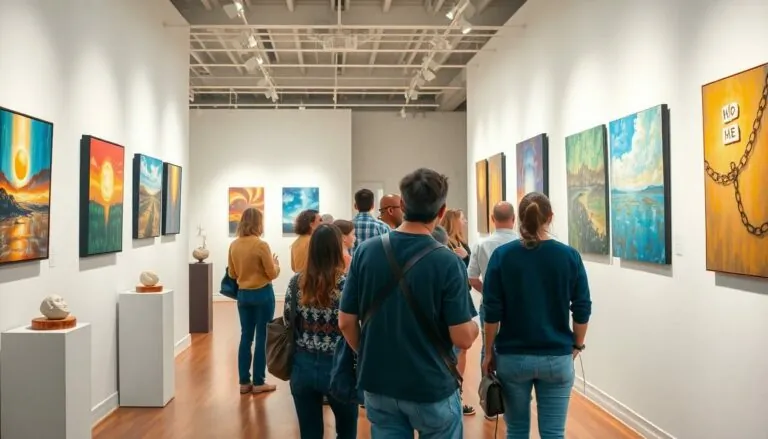Table of Contents
ToggleIn a world where everyone’s snapping selfies and capturing brunch plates, church photography stands out as a unique art form. It’s not just about capturing the choir’s best side or the pastor’s most inspiring moment; it’s about preserving the spirit of community and faith. Imagine a photo that doesn’t just show a building but tells a story of hope, connection, and a sprinkle of divine light.
Whether it’s a wedding, baptism, or Sunday service, church photography has the power to freeze those fleeting moments in time. It’s like having a time machine that transports you back to that joyful day every time you glance at the images. So, grab your camera and let’s explore how to elevate church photography from mere snapshots to cherished memories that even the most discerning congregants will adore.
Overview of Church Photography
Church photography captures the spiritual essence of worship and community life. Its focus extends beyond rituals to embrace the warmth of gatherings, the emotional weight of ceremonies, and the richness of communal faith. Vital moments like weddings and baptisms resonate deeply, allowing congregants to revisit significant life events.
Various aspects contribute to the effectiveness of church photography. Lighting plays a crucial role in highlighting architectural details and creating a serene atmosphere. Different angles can reveal the beauty of stained glass windows and the joy on attendees’ faces. Photographers often aim to balance candid shots with posed portraits, ensuring a comprehensive documentation of events.
Photographers must also consider the diverse range of church activities. From Sunday services to holiday celebrations, each occasion presents unique opportunities for storytelling through images. Engaging with congregants, understanding their stories, and capturing genuine interactions leads to more meaningful photographs.
The choice of equipment significantly impacts the outcome. Cameras with higher performance in low light ensure images remain vibrant during evening services. Lenses that offer flexibility enable creative compositions and close-ups during intimate moments.
Editing further enhances the storytelling potential of church photography. Post-processing techniques can highlight the atmosphere and emotion of each shot, conveying the community’s spirit. When done thoughtfully, edits maintain authenticity while elevating the overall visual narrative.
Ultimately, church photography serves as a bridge between moments of faith and the families that honor them, transforming fleeting experiences into lasting memories.
Importance of Church Photography

Church photography plays a crucial role in preserving the spiritual journey and shared experiences of congregants. This art form captures meaningful moments that resonate deeply within the community.
Capturing Spiritual Moments
Significant experiences like baptisms, confirmations, and communion services hold profound meaning. Each click of the camera captures emotions and connections, revealing the beauty of faith. Portraits of individuals in prayer or moments of reflection convey deep spirituality. Photographs immortalize these sacred moments, allowing individuals to revisit their spiritual milestones. Engaging closely with subjects enables photographers to capture authentic expressions of devotion. Each image serves as a reminder of personal journeys within the faith, promoting a sense of belonging and continuity in religious life.
Documenting Community Events
Church photography also documents community gatherings such as potlucks, charity events, and service projects. Through images, these occasions highlight unity and collaboration among congregants. Group photos of volunteers showcase teamwork and dedication to a common cause. Capturing interactions during these events reveals the strength of relationships formed within the church. Moments of laughter, sharing, and support illustrate the community’s vibrancy. These photographs convey stories of kindness and togetherness, cementing the congregation’s legacy. Each photo acts as a visual reminder of the shared mission and fellowship that enriches the church community.
Techniques for Effective Church Photography
Effective church photography captures the essence of faith and community. Photographers can enhance their work through specific techniques.
Choosing the Right Equipment
Selecting the appropriate equipment influences the quality of photos. Cameras with good low-light performance excel in church settings. Lenses with wider apertures enable better light absorption. Additionally, using a tripod stabilizes shots during low-light conditions. For photographers seeking flexibility, interchangeable lens systems provide various options for different scenarios. Overall, quality gear ensures clarity and detail in every captured moment.
Lighting Considerations
Lighting plays a crucial role in church photography. Natural light often emanates through stained glass windows, creating unique atmospheres. Utilizing a combination of available light and external flashes enhances image quality. Positioning subjects in relation to light sources captures dynamic shadows and highlights. During evening services, adjusting camera settings for higher ISO accommodates darker environments. Prioritizing soft, diffused lighting increases warmth and intimacy in portraits. Overall, mastering lighting techniques results in compelling and meaningful images.
Best Practices for Church Photography
Effective church photography captures the profound essence of community and faith. Adhering to best practices enhances the overall experience for both photographers and congregants.
Respectful and Ethical Considerations
Respect during church photography stems from understanding the sacred nature of the environment. Photographers must seek permissions before capturing images, especially during sensitive moments. It’s essential to be aware of and honor the wishes of congregants regarding their participation. Privacy matters; individuals may not want their images shared publicly, even if they are attending services. Observing the atmosphere contributes significantly; a respectful demeanor while photographing keeps the focus on the spiritual experience. Always remain unobtrusive to avoid disrupting worship or other significant events.
Engaging with the Congregation
Engagement with congregants fosters authentic representations of their faith journeys. Establishing rapport allows photographers to capture genuine emotions and candid moments. Asking open-ended questions encourages congregants to share their stories, enriching the narrative conveyed in photographs. Connecting with members prior to events helps in understanding their preferences and expectations. It promotes a sense of belonging; individuals feel valued when asked about their experiences. Being present at various gatherings, from services to community events, deepens relationships and leads to more impactful imagery.
Church photography is more than just capturing images; it’s about telling a story that resonates with faith and community. By honing their skills and understanding the nuances of light and composition, photographers can create powerful visuals that celebrate significant spiritual milestones. Engaging with congregants fosters authentic connections that translate into heartfelt images.
The impact of these photographs extends beyond the church walls, preserving memories that families can cherish for generations. As photographers embrace the emotional depth of worship and community life, they contribute to a legacy that honors shared experiences. Ultimately, church photography enriches the spiritual journey, transforming fleeting moments into enduring memories that reflect the beauty of faith.







